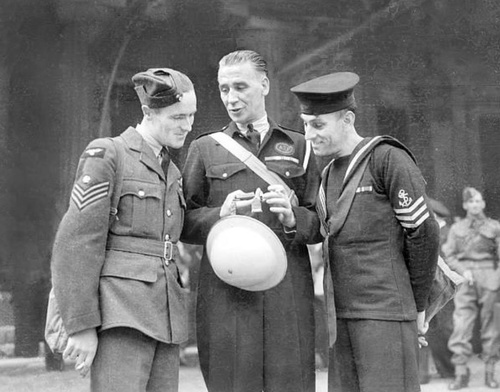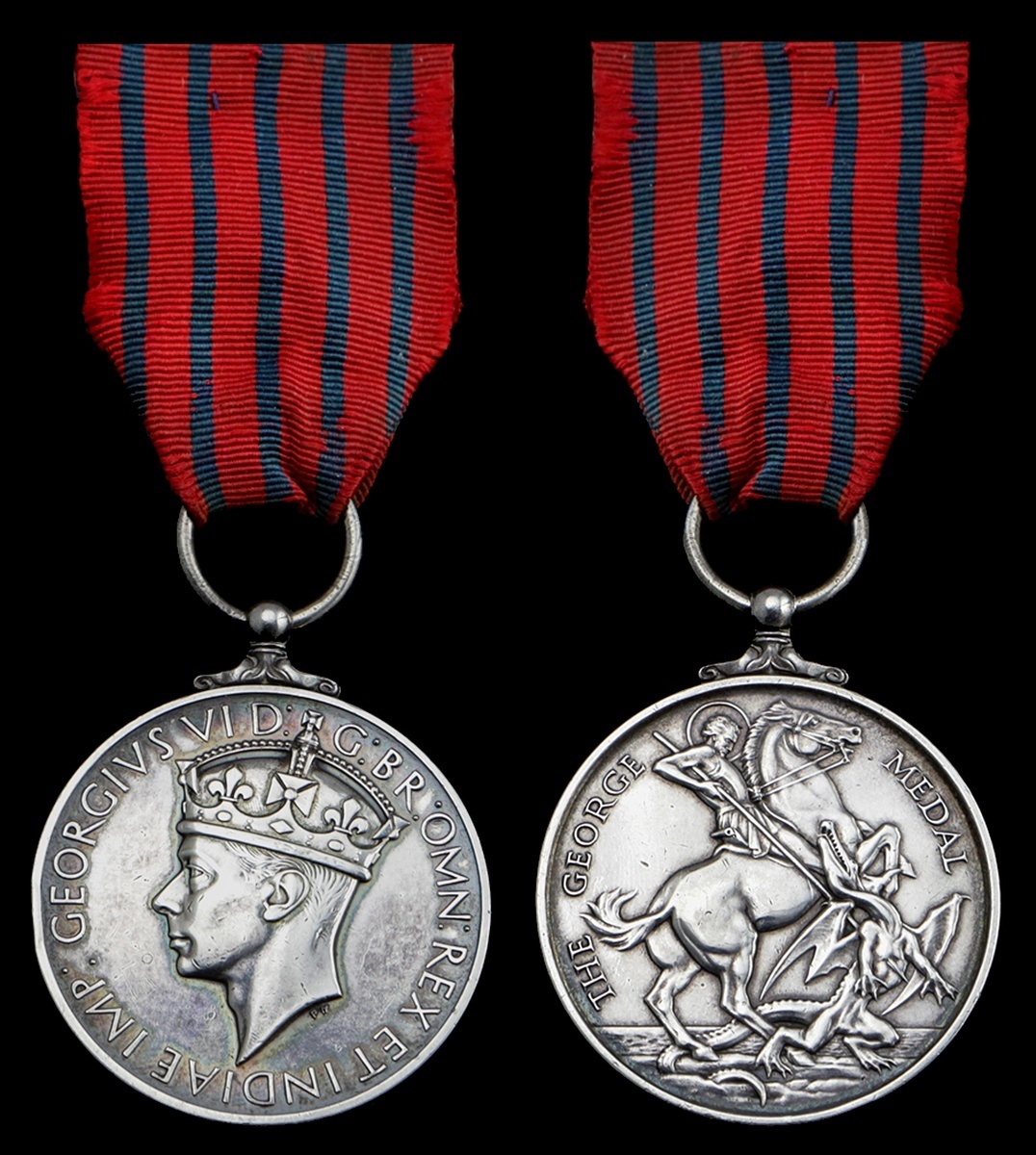Auction: 18001 - Orders, Decorations and Medals
Lot: 590
Sold by Order of a Direct Descendant
A fine 'London Blitz' G.M. awarded to Air Raid Precautions Officer and Depot Superintendent J. Brennan, late of the Royal Navy and a veteran of the battle of Jutland, who rescued a woman who was trapped in a coal gas filled crater caused by a high explosive bomb in Whitmore Gardens, Kensal Rise on the night of 17 November 1940
The opinion of a doctor on the scene was that the woman's right leg would have to be amputated to facilitate her release, so Brennan moved swiftly to avert such a tragic outcome: working for nearly an hour amidst a strong concentration of coal gas - and clear in the knowledge that three floors of the house remained precariously overhanging him and that enemy bombers remained in the vicinity - he had to be assisted from the scene on freeing the woman from her perilous position
His motivation no doubt stemmed from personal circumstances for, according to family sources, he had earlier been invalided from the Royal Navy after losing his right leg below the knee
George Medal, G.VI.R. (James Brennan), on original wearing pin, nearly extremely fine
G.M. London Gazette 23 May 1941:
'A bomb partially demolished a house and a woman was trapped from the knees downwards beneath some debris. To effect her rescue it was necessary for the woman to be lifted almost to a standing position and held there to allow someone to work near her feet. While she was being held up, Mr. Brennan slid down into the crater on his stomach and worked there for some considerable time, removing bricks by hand.
Although there was a strong concentration of coal gas in the hole where he was laying head downwards, Mr. Brennan persisted in his efforts and after some time the casualty was released and removed to hospital. Throughout this incident Mr. Brennan was in danger from the wreckage under which he was working, from the ruins of the house, which were likely to collapse at any moment, and from the high concentration of gas.'
James Brennan was born in Dublin, Ireland on 24 July 1899 and entered the Royal Navy as a Boy 2nd Class aboard H.M.S. Impregnable in June 1915. He remained likewise employed until coming ashore to Victory at the year's end but returned to sea in the battleship Malaya in the new year. He was subsequently present at Jutland, on which occasion the Malaya took eight hits and suffered 65 casualties.
In between home service at Devonport, Brennan also served aboard the battlecruiser New Zealand and the battleship Ramillies, receiving his war gratuity aboard the latter. However, with the cessation of hostilities and his coming ashore to Vivid I, his career was curtailed on 14 January 1920, his service record noting 'Invalided.' This correlates with family accounts which indicate that he lost his right leg below the knee; accordingly he wore a prosthetic at the time of the incident resulting in the award of the George Medal.
Of those memorable events at 51 Whitmore Gardens, Kensal Rise, on the night of 17 November 1940, the following witness statements add further detail:
Report by M. A. C. Ritter, Chief of Staff to Controller:
'The action took place on the 17th of November at 21.00 hours in Whitmore Gardens. I understand Mr. Brennan arrived on the scene, having cleared up the situation at Liddell Gardens, and found the woman trapped from the knees down in a hollow caused by the explosion, the hollow was filled with coal gas and the woman was being held upright by a bystander to keep her face clear of the gas.
Mr. Brennan, I understand, arrived with a doctor who had been sent for by one of the Stretcher Party and the general opinion was then formed that if the woman was to be released there would have to be an amputation.
Mr. Brennan said he would attempt to release the woman without this amputation being effected.
Over the hollow in which the woman was, there were overhanging three floors of the house which were in imminent danger of collapse from any vibration.
The space between the floors and the hollow would only admit of the passage of one human person.
Mr. Brennan got down on his stomach, crawled through and under this debris, immediately breathing coal gas. It was impossible to use any tool to release the woman's legs and all the debris round her legs had to be removed by hand which feat Mr. Brennan accomplished.
After the episode I understand Mr. Brennan was much affected by the coal gas.
I would close by saying that this is one of many similar incidents in which Mr. Brennan has taken a leading part.'
Report by Station Inspector E. Gahan:
'On 16th November, 1940, at about 7.30 p.m. I attended an incident where an H.E. bomb had partially demolished Nos. 51 and 53 Whitmore Gardens, Kensal Rise. There were seven people in the houses when the bomb fell and five of these were assisted out shortly afterwards. The sixth person, a man, was dead when removed which left one woman, age about 50, who was trapped by her right leg beneath some debris at the back of No. 51.
As this woman was injured and in some considerable pain, and also to avoid the inevitable delay which would be caused by removing large quantities of debris lying on top of the place where she was trapped, Mr. Brennan decided to try and remove the brick and woodwork which were immediately on top of the woman's leg by which she was pinned down.
To effect this it was necessary for the woman who was crouched down in a small crater in the debris, to be lifted almost to a standing position and held there to allow someone to work near her feet. Whilst the woman was being held up Mr. Brennan slid down into the crater on his stomach underneath the woman's body and worked there for some considerable time, removing bricks by hand.
However, as little headway was made and the woman was in obviously very great pain a doctor was sent for and with Mr. Brennan's assistance administered a morphia injection. The question of amputating the leg was raised but Mr. Brennan decided that he would make another attempt to free her before such a step was taken.
Mr. Brennan again resumed his former position despite offers of assistance and although there was a strong concentration of coal gas in the crater where he was lying head downwards. After some time the woman was released and removed to hospital.
Throughout the incident Mr. Brennan was in no small danger from the wreckage under which he was working, the high concentration of gas and from the rest of the house which was left in imminent danger of collapsing.
The whole of this action which took place while enemy aircraft were in the immediate vicinity lasted about 50 minutes. Mr. Brennan was much affected by the coal gas and by his exertions and had to be assisted out into the street.
I was a witness of everything that took place and must add that the work Mr. Brennan did is deserving of very high praise, considering the difficulties of the situation and the personal risks he took.'
Report by A. H. Weavers, Stretcher Party Leader:
'I was present at the incident in Whitmore Gardens on 17th November 1940. When I arrived Mr. Brennan was working in a hole attempting to release a woman who was trapped by debris. There was a broken gas pipe in the hole from which gas was escaping into and filling the hole with fumes. It was obvious that if the debris was not removed very carefully and slowly the upper part of the house which was overhanging the hole would collapse on to it. A doctor who was present wanted to amputate the woman's leg, but Mr. Brennan persisted in his efforts and at considerable personal risk, both from the coal gas and the overhanging debris, was finally successful in freeing the woman without calling upon the doctor to perform an amputation. I consider this a very brave and resourceful action.'
Report by A. Ralph, Deputy Assistant Commissioner:
'I am forwarding direct to you a report by Station Inspector Gahan of "X" Division Police, dealing with the conduct of Mr. Brennan at Whitmore Gardens on 16th November, 1940.
I am not surprised at the contents of the letter because it is the sort of action I should expect from Mr. Brennan. I have made contact with him several times at different incidents, some of a major character, and I have been impressed with his excellent behaviour. Not only does he set a good example to those under his control by his fearless and energetic conduct, but - what is equally important - he works in an excellent relationship with Police and the other services.
I have pleasure in adding my testimony for what it is worth as I am fully of the opinion that Mr. Brennan deserves some recognition for this efficient work as an Incident Officer.'
Brennan received his G.M. at a Buckingham Palace investiture held on 7 October 1941; his Great War campaign medals are understood to have been lost in the Blitz.
Subject to 20% VAT on Buyer’s Premium. For more information please view Terms and Conditions for Buyers.
Sold for
£3,200







